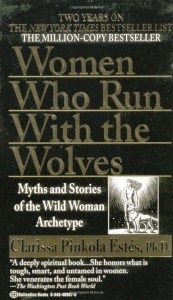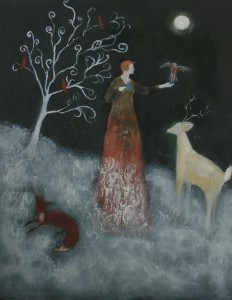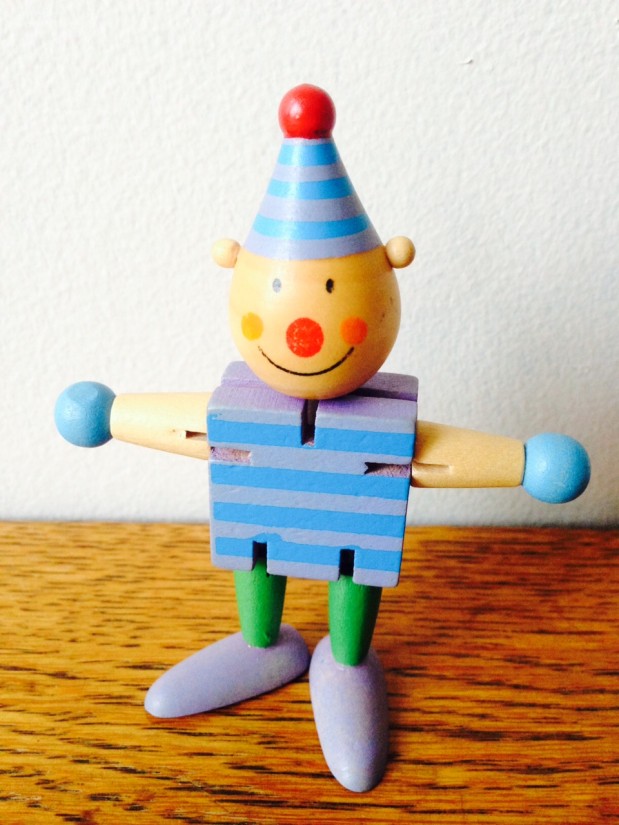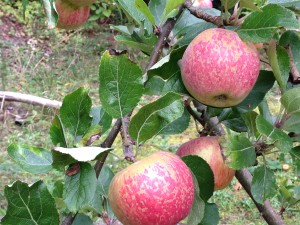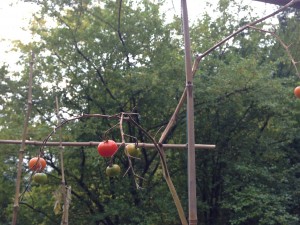Midway Through My Kindle Scout Campaign: Some Thoughts About Its Worth
I’ve just passed the midway point through my 30 day Kindle Scout campaign for my book Reconcilable Differences and am checking in with my results and experience thus far. If you didn’t catch my last post about my path to publishing, at the end I introduced my latest venture.
To recap: Amazon runs the Kindle Scout program to which authors submit unpublished works (title, cover, longline, 50 pp sample and an author bio/blurb) and, if selected, provides a 30 day opportunity to expose your book to the public and solicit nominations through your network/social media. After this time, they either offer to publish your book… or they don’t. The implication is that the number of nominations you receive affects the deal, but I’m not entirely convinced. More on this later.
What my Kindle Scout landing page looks like:
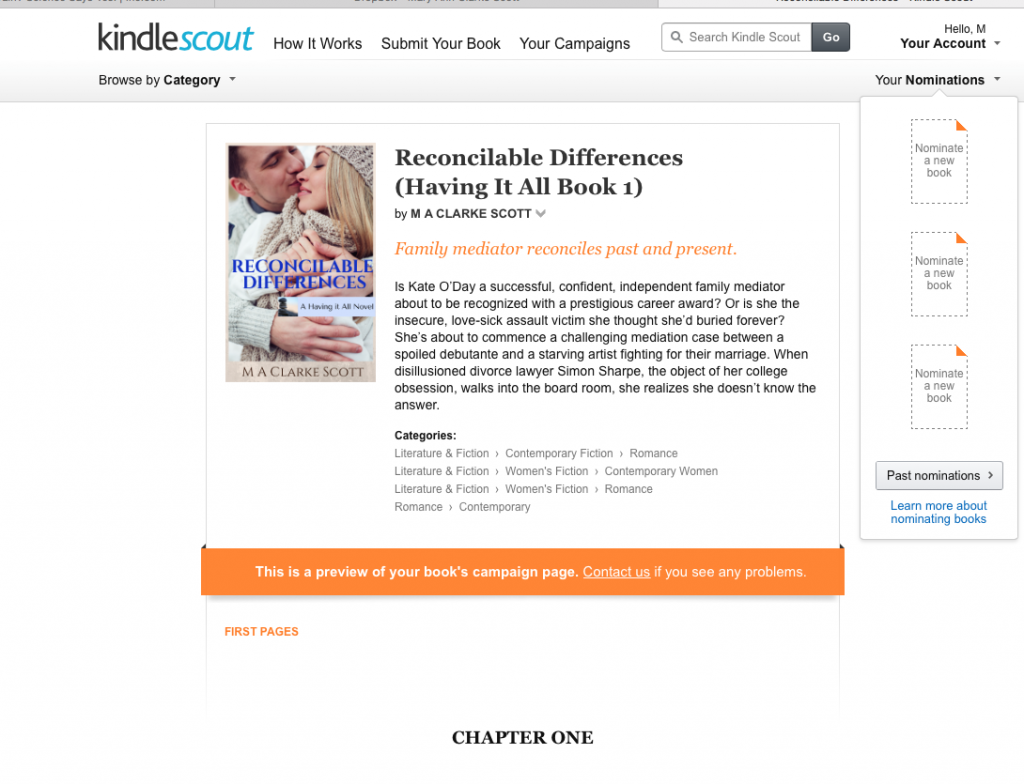
No Harm Trying
As I was preparing Reconcilable Differences for independent publishing anyway, I figured there’d be no harm experimenting with this relatively new Amazon publishing program. Some early-adopter authors, such as self-publishing guru Martin Crosbie, and Lexi Revellian, have found success. If I were published by Amazon, it sounded to me like a very good option for a debut author with a smallish social network and a limited capacity for social media marketing. If I didn’t make the cut, well, back to Plan A.
Social Media Reach
Since I’ve been at it for quite a number of years (9-10?) I actually thought my social media reach would be reasonable. Despite being a lazy, infrequent blogger, I’m somewhat active on several platforms, including Twitter, FB, Pinterest, LinkedIn and now Instagram. What I’m discovering (not that I haven’t been told this before) is that you need a huge (as in thousands and thousands) of connections, OR a very loyal, devoted and passionate following of around a thousand. I have neither.
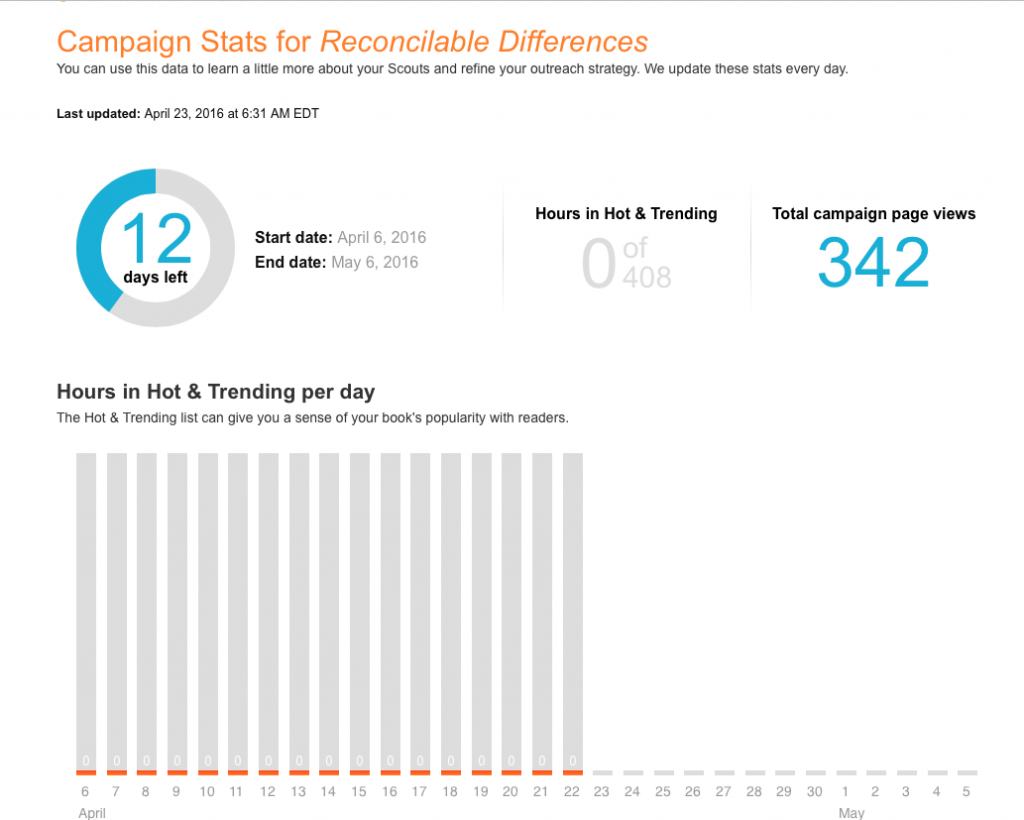
Definitely NOT Hot & Trending
Possibly for this reason, despite shamelessly flogging my campaign this past 18 days, my “page view” results have been very, very modest. Quiet, one might say. As of Day 18 I’ve had only 363 page views. This has qualified me for the mysterious but vaguely desirable Hot & Trending list exactly ZERO hours so far. I can’t tell you what it’s like to drop-kick your baby out into the wide world and receive such a resounding… whisper.
What Does It All Mean?
Nevertheless, there are several terrific things that have come of the experience already.
The first is that I forced myself to go out there and actually promote my own work, something many an introverted writer will tell you is akin to sticking pins in your eyes. I posted on comfy and familiar channels, such as Facebook, where presumably my “friends” are fairly indulgent and supportive, although I suspect their patience is wearing thin. I personally solicited family and friends by email. I’ve tweeted to a broader mixed audience, and I’ve even mentioned it quietly on LinkedIn, a professional networking environment seemingly more conducive to the exchange of ideas than the flogging of wares. I’ve also pinned it on Pinterest but I don’t think I’ve had any page views linked from that source, and created ‘events’ on Goodreads and had some results. Some of this data is made available to Kindle Scout authors through statistics that update every 24 hours. For me this occurs somewhere between 3 and 3:30 am. And no, I don’t get up to check. It’s just not that exciting.
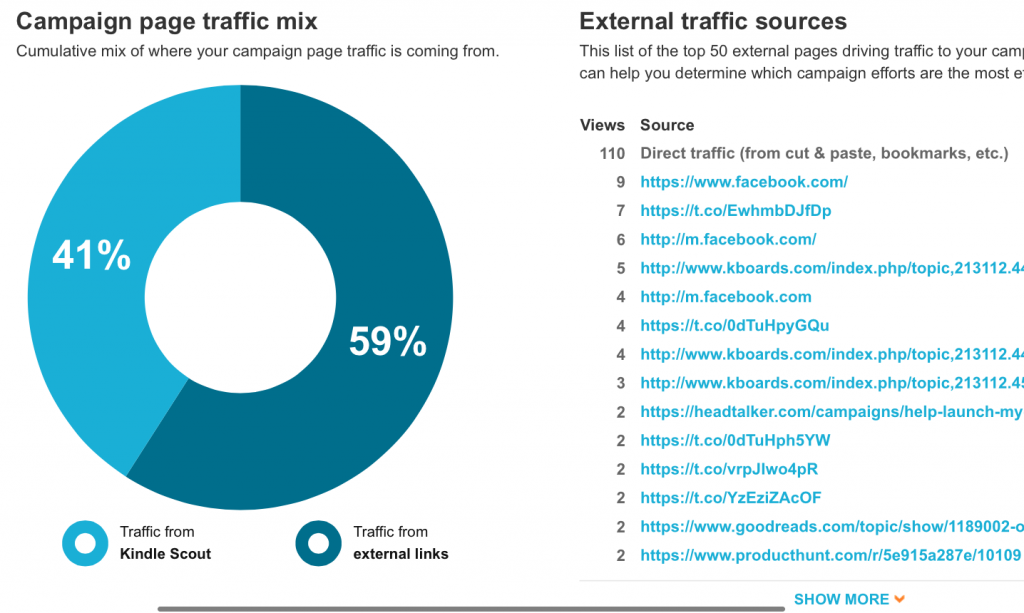
It’s interesting to see where the external traffic comes from though. The range of externally linked traffic gives some idea of how effective my marketing efforts have been. Although the effect is small, this is still very useful information going forward. If I make noise, who is listening? And who is more likely to take action? During the 18 days of my campaign so far, the split between internal Kindle Scout traffic and external links has remained constant at approximately 40-60.
So what does it all mean, and what is likely to happen next?
My and Others’ Thoughts On The Program
I’ve also participated on a number of writer forums, such as KindleBoards, writer’s group’s such as RWA, WFWA, Writer Unboxed and author blogs, and got involved in a few discussions. There are a variety of opinions out there among authors about the risks and rewards of the Kindle Scout program.
It seems to me those that take a cynical approach are likely in the habit of hedging their bets, and not allowing their hope too much reign. It’s easy to get hurt in this business. Too easy to be deeply disappointed yet again. So never letting yourself expect much might seem the safest bet of all. Those of you who are writers will understand that’s it’s never easy, no matter which route you choose to publishing, or how you go about managing your business afterwards. The facts of Kindle Scout are more optimistic.
Do The Nominations Even Matter?
Popular topics of discussion among participant authors include whether being on the Hot & Trending list is important for selection, and what the most important factors for selection might actually be. Reports from the battlefield indicate that no, the Hot & Trending list doesn’t matter. There are reported cases of books that spend a full 30 days on the Hot & Trending list getting a pass, and books that never hit the Hot & Trending list getting publishing deals.
While this is especially encouraging in my case, it’s interesting to speculate why. This seems obvious to me. Everyone knows you can buy supporters and reviews, and even buyers of books. Amazon knows this too. This is one of the reasons there are so many rules around who can leave book reviews on their site, and why those rules keep changing. They’re interested in staying one step ahead of the players, hackers and scammers who think they’re clever enough to “work the system.” Even earnest, hard working authors who try simply to understand how things work in order to do better have the rug pulled out from under them on a regular basis.
What Is Amazon Looking For?
Which leads me to believe that a) you can’t really fool an organization a large and powerful as Amazon, and b) they are ultimately interested in your book succeeding on it’s own merits. Not that they won’t help you along if they want to. It’s the power of Amazon marketing that makes publishing through them so desirable.
And if that’s true, then what really makes your book competitive?
I have theorized that Amazon may be interested in evaluating potential authors’ social reach and social media marketing savvy, and use the campaign results to do so, but others disagree with me. They may also be interested in the general public appeal of the candidates as a measure of their future success. But as was pointed out to me, why would Amazon care about this? If they want to sell something, they know how. Unlike most other publishers, they don’t need our help. Point taken.
Are All Nominations Equal?
Also, so many of the book covers are amateurish or just plain awful, that I wonder if what attracts page views has more to do with which genres are popular with the demographics that are more likely to hang out at Kindle Scout or respond to social media appeals than they are with the books themselves. Do the people nominating books actually take the time to read the sample pages? It also makes me wonder if nominations are weighted by Amazon according to the online behavior, nomination history, and perhaps most important, past book-buying practices, including the relevance of genre to the candidate’s.
One other marketing experiment I tried was to create a HeadTalker campaign. HeadTalker is a crowd-sourced promotion tool, like crowd-funding, that leverages the social networks of your supporters to send out a huge blast of announcements. I managed to get 25 supporters for my campaign within the deadline, so I’ll see within the next day or two whether the 969,780 reach makes an impression on my Kindle Scout campaign. And ultimately, whether this kind of social support makes a difference to Amazon.
Bottom line, the story and the writing, as always, are most important. Every book will find its readers eventually, even a quiet one. And the measure of a reader’s satisfaction rests with the story itself. You may need a little editing, and help designing a more appealing cover, but Amazon, like other publishers, will help you with that. It’s in their interest to do so. You may get only 50% royalties, but they get the other half, so your success is theirs as well. But the books, and the authors, that will sell are the ones that people want to read, and enjoy. So after all is said and done, I think I’ll put my faith and hard work into more and better writing, and leave the mysteries of marketing to others.
Losses, Gains and Opportunities
My impressions are that writers who’ve been selected for publication have been treated well by a professional and supportive team of editors, designers and marketers at Amazon, and have no regrets about participation in the program. Whether you see it as a loss leader, a great way to launch, or a reliable and relatively pain-free way to pursue publishing for all of your projects, you won’t do worse with Amazon than on your own, with the big five or a boutique digital press, and you might actually do better.
My Kindle Scout Campaign

Reconcilable Differences cover
You can help my campaign, and perhaps help Reconcilable Differences get published. Please click the link and have a look, and if you think the book is worthy, give it your vote. Also please pass this along to friends, family and other readers who might be interested in helping out. As a bonus, those who vote for a successful candidate receive a free e-book as thanks. So we all win! If you don’t mind checking out the book, here’s the link: https://kindlescout.amazon.com/p/JXXN1LUS2SHW

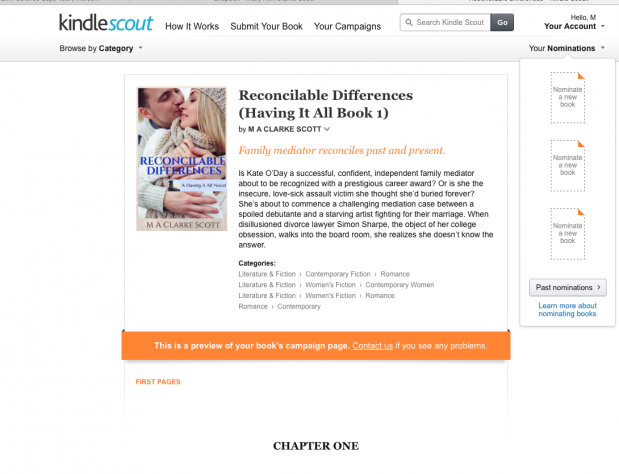
 I can still remember like it was yesterday the evening almost eleven years ago that I sat beside my husband in bed, doing aptitude tests and reading books like What Colour Is My Parachute? It wasn’t the first time I was trying to decide what I wanted to be when I grew up. I’d already been to university for years and earned several degrees. I’d tried to put all that worthy education to good use by building not one but two professional careers, first as an architect, then as an academic researcher in gerontology, and then, rather feebly, as an architect again.
I can still remember like it was yesterday the evening almost eleven years ago that I sat beside my husband in bed, doing aptitude tests and reading books like What Colour Is My Parachute? It wasn’t the first time I was trying to decide what I wanted to be when I grew up. I’d already been to university for years and earned several degrees. I’d tried to put all that worthy education to good use by building not one but two professional careers, first as an architect, then as an academic researcher in gerontology, and then, rather feebly, as an architect again.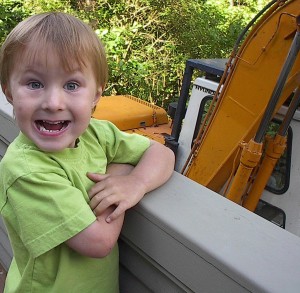 Then a baby, aging parents and a huge home renovation got in the way. Et voila, five years vanished. Strangely, I put good use to my architectural training being my own house designer and project manager, and I put all that valuable gerontology knowledge to good use caring for my mother-in-law and mother. But once junior was in full time kindergarten, I began to get restless and look for new outlets for my energy and creativity. Thus the soul-searching moment I mentioned above. At that point in my life I really needed to close those doors and move into a new arena.
Then a baby, aging parents and a huge home renovation got in the way. Et voila, five years vanished. Strangely, I put good use to my architectural training being my own house designer and project manager, and I put all that valuable gerontology knowledge to good use caring for my mother-in-law and mother. But once junior was in full time kindergarten, I began to get restless and look for new outlets for my energy and creativity. Thus the soul-searching moment I mentioned above. At that point in my life I really needed to close those doors and move into a new arena. Or not completely new, as I’d always been an avid reader and book lover, and had attempted to craft my first novel at the age of nine. I made it (longhand on yellow foolscap) ten chapters in before something else stole my attention away. But I never lost the desire, and the books, or their genesis, accumulated inside my head over the years, like secret friends whose voices called to me.
Or not completely new, as I’d always been an avid reader and book lover, and had attempted to craft my first novel at the age of nine. I made it (longhand on yellow foolscap) ten chapters in before something else stole my attention away. But I never lost the desire, and the books, or their genesis, accumulated inside my head over the years, like secret friends whose voices called to me. Five years came and went in the blink of a cursor, and no book publishing happened. I suppose for some writers it happens faster, but I believe for most there are many quiet years of devotion and diligence, and perhaps dabbling, that precede those fabulous debuts. But the path to publishing is paved by many a stumbling block. Mine included perfectionism, an addiction to research and learning, crushing self-doubt (a cliché in our business), a desire to learn how to navigate the online world of social media in order to build my author “platform”, a desperate attempt to learn about and keep abreast of the quickly shifting sands of the publishing industry. All necessary parts of the author’s career. Oh, and did I mention crushing self-doubt? None of these new challenges came easily, especially the digital-technical stuff, which seems to get harder the older I get.
Five years came and went in the blink of a cursor, and no book publishing happened. I suppose for some writers it happens faster, but I believe for most there are many quiet years of devotion and diligence, and perhaps dabbling, that precede those fabulous debuts. But the path to publishing is paved by many a stumbling block. Mine included perfectionism, an addiction to research and learning, crushing self-doubt (a cliché in our business), a desire to learn how to navigate the online world of social media in order to build my author “platform”, a desperate attempt to learn about and keep abreast of the quickly shifting sands of the publishing industry. All necessary parts of the author’s career. Oh, and did I mention crushing self-doubt? None of these new challenges came easily, especially the digital-technical stuff, which seems to get harder the older I get.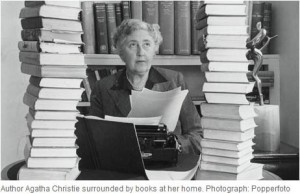 Having several completed works is one of the side benefits of working diligently for eleven years– I have an “oevre.” And I’m certain at least one of those books will be published very soon. One way or another. I now have a solid sense of the industry and my place in it, and a lot more confidence about how I want to manage my writing career.
Having several completed works is one of the side benefits of working diligently for eleven years– I have an “oevre.” And I’m certain at least one of those books will be published very soon. One way or another. I now have a solid sense of the industry and my place in it, and a lot more confidence about how I want to manage my writing career.